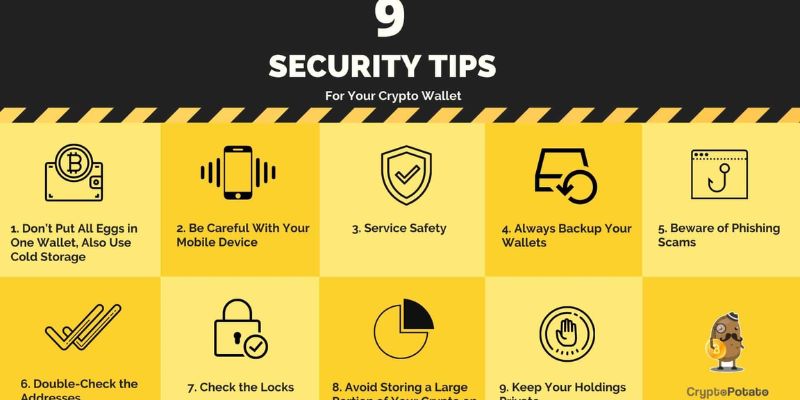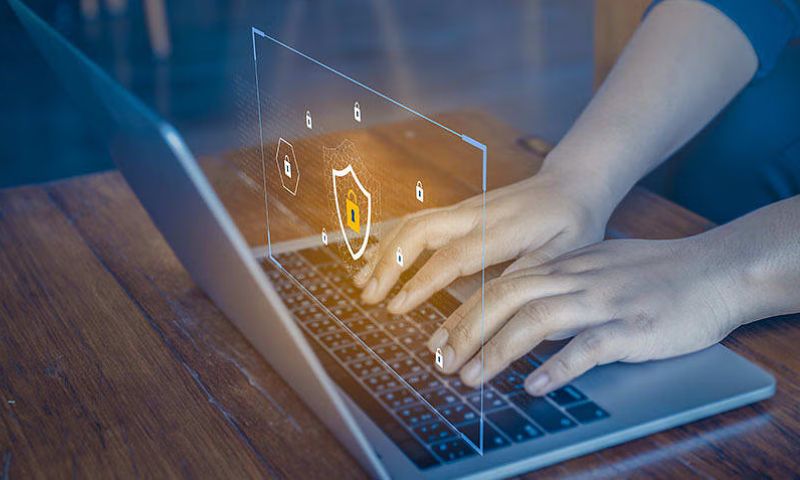Best practices for crypto wallet security are not just wise; they’re vital. Your stash of digital coins is a treasure trove that demands top-notch security. Imagine them as rare gold coins tucked in a high-tech vault. You wouldn’t leave that vault unlocked, right? From choosing strong storage to smart defense moves, each step you take can mean the difference between safe keepings and a hacker’s payday. So let’s dive in, sharpen those security skills, and turn your wallet into a digital Fort Knox!
Establishing Solid Foundations for Wallet Security
Embracing Cold Storage and Hardware Wallets
To keep your crypto safe, think about using cold storage. It’s like your own digital safe. A hardware wallet, which is cold storage, keeps assets offline. That means hackers can’t touch them. It’s like locking precious metals in a vault. With them, you control your coins completely. No surprise they’re popular among savvy users.
Hardware wallets look like USB sticks. They connect to your computer when you need to move coins. Otherwise, they stay unplugged. This keeps crypto away from the internet’s reach. Many respected brands offer these devices. Research them to pick the best one for you. Always buy hardware wallets new, and get them directly from the maker. Used ones could be tampered with, and that’s a risk you can’t take.
Understanding the Vital Role of Private Key Management
Think of private keys as your wallet’s most secret code. You must keep them safe. They’re what you use to access your crypto. If someone gets them, they could steal your assets. This is where multi-factor authentication (MFA) steps in. It adds extra security layers. MFA might use something you have, like a phone, something you know, like a password, or something you are, like your fingerprint.
Write down your private keys or backup seed phrase. Do this on paper and store it where only you can find it. Don’t keep it on your computer or phone. Cyber thieves can’t hack paper. But remember, paper can get lost or damaged. Think about fire and waterproof options.
Be smart, also keep backups in a second place, like a safe deposit box. Tell someone you trust about your backup. Not the details, but where to find it. If something happens to you, your crypto isn’t lost forever.
Remember, private keys are not to share. They’re private for a reason. Keep them secret, keep them safe. Using encryption can also help. Encryption turns data into a code. This way, if someone does get your keys, they won’t be able to use them.
Security tools can keep your digital wallet safe too. Antivirus and anti-malware help fight off attacks from bad software. Make sure your devices’ operating systems are up to date. Old versions can have holes that hackers use.
Browsers can have extensions that are risky. They can see what you see online. So, choose wisely and always log out of your wallet when done. Email is another spot where trouble can hit. Phishing emails try to trick you. They want you to give up your keys. Learn how to spot these scams to steer clear.
A VPN can hide your online actions. Use one when doing crypto stuff to keep prying eyes away. Avoid using public Wi-Fi for your wallet. It’s not safe. Hackers can watch what you do on open networks.
Two-factor authentication is another good move. It means needing two types of proof before accessing your wallet. This can block bad guys, even if they have your password.
If you have a hardware wallet, think about where you keep it. Physical theft is a risk too. Lock it up like you would cash or jewelry.
With multisig wallets, you need more than one key to move crypto. This is like a safety deposit box that needs two keys. It makes it tough for thieves to break in.
Have a routine where you check your wallet’s security. Think of it like a regular health check-up, but for your digital cash. It can stop security snags before they grow big.
And if you hear about SIM swap scams, that’s someone stealing your phone number. Then they can bypass text-based two-factor authentication. So, it’s wise to know how to keep your SIM card safe as well.
In the end, these steps build a strong security base for your wallet. They help you avoid cyber traps and keep your digital gold secure.

Proactive Measures Against Digital Threats
The Importance of Multi-Factor Authentication
Keep your crypto safe with multi-factor authentication (MFA). It’s like a secret club with two passwords, instead of one. That way, even if a hacker finds one, they can’t get in. You need both to open the door to your digital gold. For example, you type your password and then enter a code from your phone. This makes sure it’s really you.
MFA is a big deal for digital wallet protection. It’s your front-line defender against sneaky thieves. With MFA, even if your password gets out, your wallet stays locked tight.
Here’s how you get started. First, pick a good MFA app. Next, link it to your wallet. It’s that easy. Every time you log in, you’ll use your password and the app. Double protection means double peace of mind.
Strategies to Combat Phishing and Software Wallet Vulnerabilities
Beware of phishing – it’s when bad folks trick you into giving your info. It’s like a fake friend asking for your house keys. Say no to fishy emails or texts that ask for personal data. Don’t click on strange links, either. They can lead to trouble.
Smart moves keep your software wallets safe. First, use a strong password – mix up letters, numbers, and symbols. It’s like having a tough lock on your door. Then, keep your eyes peeled for updates. They patch up any holes, so hackers can’t slip through.
Protecting seed phrases is massive for safety. Your seed phrase is a secret map to your crypto treasure. Write it down, lock it up – maybe even in a safe. This way, no one else finds your hidden treasure.
Remember, your wallet’s security is up to you. Use MFA and watch out for phishing. Guard your wallet like a fierce dragon guards gold. With these tips, you’re set to keep your crypto secure.

Maintaining Rigorous Backup and Recovery Protocols
Crafting Comprehensive Backup Strategies for Crypto Assets
When you own crypto, it’s like gold. You must keep it safe. To start, let’s tackle backup. Get a hardware wallet or use cold storage. Hardware wallets protect your coins like a bank vault. Cold storage keeps them offline, away from hackers.
Now you might ask, “How do I back up my crypto?” First, write down your seed phrase. This is a list of words that can bring back your wallet if lost. Keep this paper somewhere safe, like a locked drawer or a safe deposit box. Make sure only you can get to it.
For extra safety, make backups of your backups. You can even split your seed phrase in half and store the pieces in different spots. Think of it like burying treasure in two places.
Remember, your private key is for your eyes only. Never share it with anyone. This key is what lets you access and move your crypto. So guard it like a secret code.
To avoid phishing attacks, be careful with emails. Only click on links from sources you trust. Scammers often try to trick you into giving them your keys. Stay sharp and don’t fall for their traps.
Lastly, keep your software wallets secure. Update them often. This helps close gaps that hackers could use to break in.
Navigating Wallet Recovery Processes with Expertise
Lost your wallet? Don’t panic. Here’s how you get it back. If you’ve kept your seed phrase safe, you’re in luck. Use those words with a new wallet, and your crypto should be back with you.
But, if you think your backup could be seen by others, move fast. Transfer your funds to a new wallet with a new seed phrase. Do this before any thieves can act.
Keep in mind, your hardware wallet might get stolen or break. To prepare, use a pin or password. Only you should know it. Write it down like your seed phrase.
Sometimes, you’ll hear about people getting hacked over the phone. It’s called SIM swap fraud. To stay safe, use two-factor authentication. It adds another lock to your wallet.
Always update your hardware wallet’s firmware. This makes sure it has the latest protection. It’s like a guard dog that gets smarter and tougher over time.
Lastly, don’t forget about multi-factor authentication. This needs several proofs before letting anyone in. It’s like having more than one lock on your treasure chest.
Keep your backup info updated. Use a multisig setup if you can. This needs more than one key to open your wallet. Regularly do checks. Stay safe by staying smart with your backup and recovery plans.

Ensuring Continuous Security in a Dynamic Landscape
Staying Ahead with Regular Wallet Audits and Security Checks
Secure your crypto like it’s precious gold. Just keeping it in a wallet isn’t enough. You must check it often. Like a pirate keeps an eye on their treasure, you must on your crypto. Make it a habit to audit your wallet. This means making sure nothing odd or out of the ordinary is happening.
What’s a wallet audit? It’s like a check-up for your wallet. It helps find any weak spots that hackers might use. Look at all the ins and outs of your digital wallet. Make sure every transaction was done by you. Also, inspect your wallet’s software. It should be the newest version. This helps keep your wallet safe from sneaky attacks.
Keep your wallet tidy too. Like you wouldn’t let strangers near your treasure, don’t store extra stuff in your wallet. Old addresses, unneeded apps, or random notes can be risky. They can give hackers a way in or clues to steal your coins. Keep it simple and clean.
To do this right, you need to know what’s in your wallet. This is where private key management comes in. Your private key is like the key to your treasure chest. It must stay secret and safe. Only you should know it.
Leveraging VPNs and Secure Network Practices for Enhanced Privacy
Keep your crypto moves secret with a VPN. It’s like moving your treasure in the dark of night. No one can track you. A VPN hides your tracks so hackers can’t follow. Use it when you’re doing anything with your crypto.
Why use a VPN? It’s for privacy. When you make a transaction, it’s hidden from prying eyes. Using public Wi-Fi without a VPN is a big no-no. It’s like leaving your treasure map out in the open.
When buying or trading crypto, you want a safe link to the internet. That’s what a VPN gives you. It’s like a secret passage for your data. With it, no one can tell where you’re going or coming from on the web.
Let’s talk safety habits for paying with crypto. Always double-check addresses before you send funds. Scammers love to trick people with fake ones. And keep your computer clean from viruses and malware. They’re like the rats on a pirate ship, gnawing away at your defenses.
Safe trading needs safe habits. This means using trusted wallet providers and crypto exchanges. They are like the trusted crew of your ship. Always on guard, helping you keep your treasure safe.
So remember, to keep your digital gold secure, stay sharp. Audit your wallet, use a VPN, and be smart about how you trade. This way, your crypto stays in your chest, safe and sound.
We’ve covered key steps to make sure your digital wallet stays safe. We started by looking at how cold storage and hardware wallets offer solid protection for your crypto. Then, we stressed how crucial it is to keep your private keys safe.
Next, we showed how using several layers of security, like multi-factor authentication, helps fight off hackers. We also talked about ways to spot and stop phishing attacks and handle software wallet weak spots.
Then, we talked about having strong backup plans ready in case things go wrong, and knowing how to get your wallet and funds back.
Lastly, we discussed the need for routine security checks and using things like VPNs to keep your online presence safe.
Staying safe in the crypto world takes effort, but with these steps, you’ve got a strong shield. Keep learning and stay sharp to protect your digital treasures!
Q&A :
What Are the Essential Practices to Keep My Crypto Wallet Secure?
Ensuring the security of your crypto wallet is paramount. Here are some crucial steps to follow:
- Use a Cold Wallet: Keep the majority of your funds in an offline wallet, often known as a “cold wallet.” This could be a hardware wallet or a paper wallet, which are immune to online hacking attempts.
- Two-Factor Authentication (2FA): Always enable 2FA for an added layer of security when logging in or making transactions.
- Secure Your Private Keys: Never share your private keys with anyone and store them in a safe, offline location.
- Regular Backups: Backup your wallet regularly to protect yourself against computer failures or human errors.
- Keep Your Software Updated: Always use the latest version of your wallet software to benefit from ongoing security updates.
Implementing these practices will strengthen the security of your crypto wallet significantly.
How Can I Recognize a Crypto Wallet Security Threat?
Staying vigilant against potential threats is vital:
- Phishing Attempts: Look out for suspicious emails or messages that mimic reputable services to steal your credentials.
- Fake Wallet Apps: Be cautious of downloading wallet apps that may be malicious clones trying to access your funds.
- Suspicious Links: Avoid clicking on links from unknown sources that could be trying to introduce malware or ransomware to your device.
Knowing how to identify these threats is the first step in protecting your wallet.
Are Hardware Wallets the Safest Option for Storing Cryptocurrency?
Hardware wallets are indeed considered one of the safest options for storing cryptocurrency because:
- They store private keys offline, making them immune to online hacking attacks.
- The physical element requires physical possession for transactions, adding a layer of protection.
- They are designed with security features like pin codes and recovery phrases for added safety.
While no method is entirely foolproof, hardware wallets provide a robust security solution for your cryptocurrency.
How Often Should I Update and Backup My Crypto Wallet?
To maintain strong security measures:
- Software Updates: Perform updates as soon as they are available to ensure you have the latest security patches.
- Frequent Backups: Make regular backups—after every significant transaction or change—and store them in multiple secure locations. This helps to protect against accidental loss due to device failure or loss.
A disciplined approach to updates and backups can help prevent loss and theft of your crypto assets.
Is It Necessary to Use Multiple Wallets for Cryptocurrency?
Using multiple wallets can be a strategic approach to enhance security:
- Spread the Risk: By not putting all funds in one wallet, you mitigate the risk of losing everything if one wallet is compromised.
- Categorize Funds: Use different wallets for daily transactions and long-term holding to keep main assets away from frequent use and potential exposure.
While managing multiple wallets requires more diligence, it can provide a safer means of handling your cryptocurrency portfolio.


